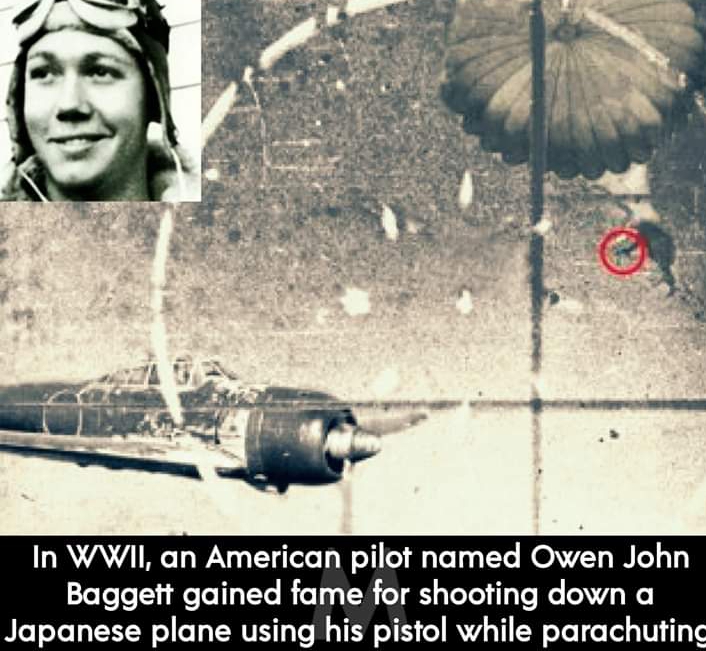The Man Who Shot Down Aircraft With Pistol

Owen J. Baggett
Owen J. Baggett served as a second lieutenant in the 7th Bomb Squadron Group of the United States Army during World War II.
Baggett was born on August 29, 1920 in Graham, Texas. He graduated from Hardin Simmons University in 1941. Baggett joined the Air Force and received pilot training on July 26, 1942 at the New Columbus Army Flying School.
World War II
Baggett's Squadron Group was working with the Air Force in India, which was responsible for defending the supply line from China to India, as well as interfering in the Japanese supply line from the north of the country to Burma.
The aircraft supplied to these units were B-24s. The main target of the Baggett unit was Burma. American pilots used to take part in long-haul flights to Pandaveswar,northwest of Calcutta.
One of those missions was that of Baggett's Mission, which was so amazing and unbelievable that it made one think of an action movie.
Mission
On March 31, 1943, Baggett was targeted for destroying a bridge in Burma.
Bagget's B-24s were intercepted by Japanese fighters as they flew toward their target. Both sides started firing. The exchange of fire severely damaged the fuel tanks of Baggett's aircraft. Lieutenant Jensen, who led the team, was also injured.
Oxygen bottles were scattered around Bagett and his companions. A crew member, Sgt. Samuel Crostick was busy trying to put out the fire.
The Japanese continued their attacks.
Baggett rushed to the scene and called for the rest of the crew to flee.
Because it became clear that no one could save the aircraft from crashing. The crew had no choice but to leave the aircraft. Shortly before the aircraft crashed, all the crew, including the Baggett, jumped out of the aircraft.
After a certain amount of time to jump off the aircraft, everyone opened their own parachutes. But trouble had not yet left them behind. When the Japanese fighters saw them heading safely to the ground, they opened fire on them.
Two of Bagett's companion were shot, while Baggett himself was shot in the arm.
Bravery
Even in such a nervous environment, Baggett controlled himself.
He fell to the ground as if he were a dead man. But he cleverly pulled his 45-caliber pistol out of the holster and tied it with his shin.
A Japanese fighter turned his aircraft around to check to see if everyone was dead.
But the pilot made a dangerous mistake.
He slowed his aircraft down and opened his canopy to look down properly. That was when Baggett, holding his pistol in his hand, fired four shots at the pilot.
The place where Baggett fell was occupied by the Japanese army. Soon Baggett and his surviving comrades were captured. They remained in captivity until the end of the war.
Baggett was the only person to become famous for shooting down a aircraft with a pistol.
Reality or Fiction?
However, there are conflicting opinions about this.
According to Japanese war records, none of their aircraft crashed in the area that day. Yes, the pilot may have been injured by a bullet, but he saved the aircraft from crashing.
A few months later, another unit, including Colonel Harry, commander of the 311 Group, passed through the camp where Baggett was being held. He was being taken to Japan.
Col. Harry said he learned that a Japanese aircraft had crashed and that the pilot had been shot in the head. Colonel Harry was told this by a Japanese colonel. Colonel Harry said that he would prepare a formal report of the incident but he died before he could do so.
One proof of the veracity of this incident is that the Japanese did not encounter any enemy aircraft in the area on that day except for Baggett's aircraft. And if no other aircraft was there, then who shot this Japanese pilot in the head?
After his release from prison, Baggett became very famous. His professional life also progressed and he rose to the rank of Colonel in the Air Force.
Baggett passed away in 2006, but the memory of his extraordinary shooting down of a aircraft with his .45 caliber handgun still lives on today.

 My First News Item
My First News Item My Nine News Item
My Nine News Item